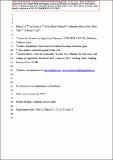Por favor, use este identificador para citar o enlazar a este item:
http://hdl.handle.net/10261/220021COMPARTIR / EXPORTAR:
 SHARE SHARE
 CORE
BASE CORE
BASE
|
|
| Visualizar otros formatos: MARC | Dublin Core | RDF | ORE | MODS | METS | DIDL | DATACITE | |

| Título: | Type III Secretion–Dependent and –Independent Phenotypes Caused by Ralstonia solanacearum in Arabidopsis Roots |
Autor: | Lu, Haibin CSIC ORCID; Lema Asqui, Saul CSIC; Planas-Marquès, Marc CSIC; Alonso Díaz, Alejandro CSIC ORCID; Valls, Marc CSIC ORCID; Coll, Núria S. CSIC ORCID | Fecha de publicación: | ene-2018 | Editor: | American Phytopathological Society | Citación: | Molecular Plant-Microbe Interactions 31(1): 175-184 (2018) | Resumen: | The causal agent of bacterial wilt, Ralstonia solanacearum, is a soilborne pathogen that invades plants through their roots, traversing many tissue layers until it reaches the xylem, where it multiplies and causes plant collapse. The effects of R. solanacearum infection are devastating, and no effective approach to fight the disease is so far available. The early steps of infection, essential for colonization, as well as the early plant defense responses remain mostly unknown. Here, we have set up a simple, in vitro Arabidopsis thaliana–R. solanacearum pathosystem that has allowed us to identify three clear root phenotypes specifically associated to the early stages of infection: root-growth inhibition, root-hair formation, and root-tip cell death. Using this method, we have been able to differentiate, on Arabidopsis plants, the phenotypes caused by mutants in the key bacterial virulence regulators hrpB and hrpG, which remained indistinguishable using the classical soil-drench inoculation pathogenicity assays. In addition, we have revealed the previously unknown involvement of auxins in the root rearrangements caused by R. solanacearum infection. Our system provides an easy-to-use, high-throughput tool to study R. solanacearum aggressiveness. Furthermore, the observed phenotypes may allow the identification of bacterial virulence determinants and could even be used to screen for novel forms of early plant resistance to bacterial wilt. | Versión del editor: | https://doi.org/10.1094/MPMI-05-17-0109-FI | URI: | http://hdl.handle.net/10261/220021 | DOI: | 10.1094/MPMI-05-17-0109-FI | ISSN: | 0894-0282 |
| Aparece en las colecciones: | (CRAG) Artículos |
Ficheros en este ítem:
| Fichero | Descripción | Tamaño | Formato | |
|---|---|---|---|---|
| Haibin_MolPlant-MicInt_2018.pdf | 5,64 MB | Adobe PDF |  Visualizar/Abrir |
CORE Recommender
SCOPUSTM
Citations
18
checked on 16-may-2024
WEB OF SCIENCETM
Citations
15
checked on 21-feb-2024
Page view(s)
117
checked on 20-may-2024
Download(s)
165
checked on 20-may-2024
Google ScholarTM
Check
Altmetric
Altmetric
NOTA: Los ítems de Digital.CSIC están protegidos por copyright, con todos los derechos reservados, a menos que se indique lo contrario.
